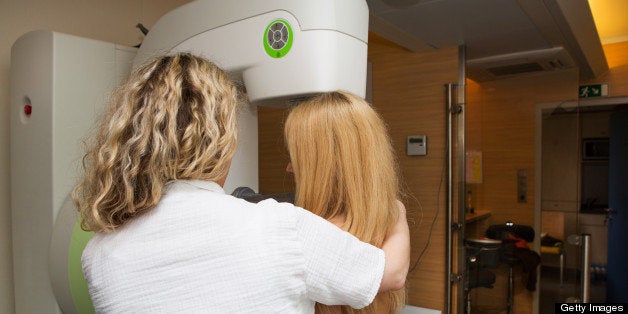
It has been more than three years since a high-profile medical task force issued controversial guidelines saying that most women age 40 to 49 should no longer get routine mammograms.
But the recommendations from the U.S. Preventive Services Task Force (USPSTF) -- an independent panel that reviews a range of preventive services -- do not appear to have had any measurable effect on whether women actually get screened. In recent years, mammography rates have not gone down in any age group, including women in that 40-to-49 bracket, a new study, published today in the journal Cancer, suggests.
"These recommendations -- which are recommendations from one of the most prominent national bodies out there --have not been widely adopted," study author Dr. Lydia Pace, a global women's health fellow at Brigham and Women's Hospital in Boston, Mass., told HuffPost. "We have not seen the decrease you would expect if these recommendations had been widely adopted."
Investigators analyzed data from nearly 28,000 women who were asked whether they'd had a mammogram in the 2005, 2008 and 2011 National Health Interview Surveys. Mammography rates actually increased slightly between 2008 and 2011, from 51.9 to 53.6 percent, and did not decrease among women age 40 to 49 after the new USPSTF guidelines came out.
Prior to 2009, the USPSTF had recommended that all women over the age of 40 get a mammogram every one to two years. The task force then changed its recommendations to biennial screening for women age 50 to 74, and against routine mammograms for women in their 40s. Because the incidence of breast cancer among younger women is relatively low, experts rationalized, a high number of women would need to be screened in order to save one life from breast cancer -- not enough of a net benefit to recommend it routinely. The task force also argued that false positives can cause psychological harm and lead to unnecessary tests and biopsies, and they are more common in women age 40 to 49.
The revision quickly sparked a controversy in the medical world, one that made headlines in mainstream media outlets.
Other major medical groups, including the American Cancer Society, continue to recommend yearly mammograms for women starting at age 40.
"We still have respected organizations that have fundamentally different recommendations when it comes to screening mammography," Dr. Len Lichtenfeld, deputy chief medical officer for the American Cancer Society, told HuffPost. "The task force has its position, the American Cancer Society and other organizations have a different position, and both sides on this discussion believe that the evidence is in their favor."
"There was a vigorous discussion in the media about it," said Dr. Therese Bevers, medical director of the cancer prevention center at the University of Texas MD Anderson Cancer Center. Bevers said she disagrees with the USPSTF recommendations. Another "big, compelling force," she said, is word of mouth.
"Some women are hearing from their friends, 'You've got to get the mammogram. It was the mammogram that found my mom's cancer, or my cancer,'" she said. "So they're hearing messages from a number of avenues."
Another possible explanation for the lack of change in mammography rates is simply that not enough time has passed since the USPSTF changed its recommendations. It can take years for a medical body's directives to filter down to doctors and their patients, and the study's authors admit that the new study may have been conducted too soon after the new guidelines were issued to detect a decline. However, similar studies looking at prostate cancer screening rates after the task force recommended against it found that screening rates dropped as soon as one year later. In that case, however, the new recommendations more closely matched those of other major medical groups.
What this means is that likely, other forces are at play. One additional possibility is confusion: In one recent survey, only 20 percent of women knew what the new USPSTF recommendations were.
"We can probably attribute some of it to confusion, and [some] to disagreement with the recommendations," said Pace. "There are some providers and patients who might simply say, 'These don't apply to me.'"
Under the Affordable Care Act, Medicare and most private insurance plans are now required to cover annual mammograms for women over age 40.
